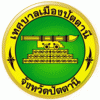Pattani (Pattani)
 |
Pattani lies 1,056 km south of Bangkok, and is located at the mouth of the Pattani River. The river may have changed course and empty into the sea at the current location in the 16th century. A small port existed in the current location at Kuala Bekah at the mouth of Sungai Patani by the early 17th century. However, the older historical centre of the Pattani Kingdom that ruled over the region of Patani was located a few miles to the east of the present city; near Ban Kru Se or Kampong Kersik, which is where the Krue Se Mosque is located. The older Patani was captured and sacked by the Siamese in 1785, and a new town centre later developed in the current location and the Sultan moved to Cabang Tiga at the southern side of present-day Pattani in the 19th century. The Patani City municipality was established in 1935 by royal decree.
The local dialect of Malay is called Patani Malay or Yawi in Thai (derived from Jawi).
Some believe that the name Pattani originated from Malay name Patani (Jawi: ڤتنا), which can mean "this beach" in Patani Malay language. (In standard Malay, this would be pantai ini.) According to a legend, the founder of Patani was a raja from Kota Malikha named Phaya Tunakpa. Phaya Tunakpa went hunting one day and saw a beautiful albino mouse-deer the size of a goat, which then disappeared. He asked his men where the animal had gone, and they replied: "Pata ni lah!" ("This beach!" in the Patani Malay language). They searched for the mouse-deer but found instead an old couple, where the old man identified himself as Che' Tani ("Mister Tani"). The old man said that he was sent by the raja's grandfather to build a new town further beyond but had fallen ill on the journey; as he could not go any further, he stayed at that place. The raja then ordered a town be built at the site where the mouse-deer had disappeared. The town became Patani, which is believed to be named either after "this beach" where the mouse-deer had disappeared. Alternatively, it has also been said to be named after the old man as Pak Tani meaning "Father Tani".
Some also say the word Pattani is derived from "Petani" in Malay which means "farmer". Another suggestion is that it derives from a Sanskrit word pathini, meaning "virgin nymph"; Pathini is also said to be the title of a daughter of Merong Mahawangsa, founder of the preceding kingdom of Langkasuka.
Map - Pattani (Pattani)
Map
Country - Thailand
 |
 |
| Flag of Thailand | |
Tai peoples migrated from southwestern China to mainland Southeast Asia from the 11th century. Indianised kingdoms such as the Mon, Khmer Empire and Malay states ruled the region, competing with Thai states such as the Kingdoms of Ngoenyang, Sukhothai, Lan Na and Ayutthaya, which also rivalled each other. European contact began in 1511 with a Portuguese diplomatic mission to Ayutthaya, which became a regional power by the end of the 15th century. Ayutthaya reached its peak during the 18th century, until it was destroyed in the Burmese–Siamese War. Taksin quickly reunified the fragmented territory and established the short-lived Thonburi Kingdom. He was succeeded in 1782 by Buddha Yodfa Chulaloke, the first monarch of the current Chakri dynasty. Throughout the era of Western imperialism in Asia, Siam remained the only nation in the region to avoid colonization by foreign powers, although it was often forced to make territorial, trade and legal concessions in unequal treaties. The Siamese system of government was centralised and transformed into a modern unitary absolute monarchy in the reign of Chulalongkorn. In World War I, Siam sided with the Allies, a political decision made in order to amend the unequal treaties. Following a bloodless revolution in 1932, it became a constitutional monarchy and changed its official name to Thailand, becoming an ally of Japan in World War II. In the late 1950s, a military coup under Field Marshal Sarit Thanarat revived the monarchy's historically influential role in politics. Thailand became a major ally of the United States, and played an anti-communist role in the region as a member of the failed SEATO, but from 1975 sought to improve relations with Communist China and Thailand's neighbours.
Currency / Language
| ISO | Currency | Symbol | Significant figures |
|---|---|---|---|
| THB | Thai baht | ฿ | 2 |
| ISO | Language |
|---|---|
| EN | English language |
| TH | Thai language |















